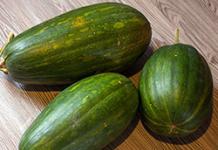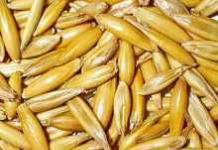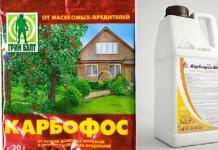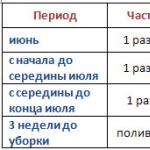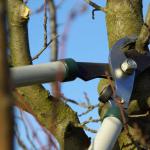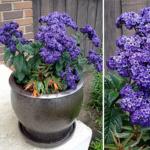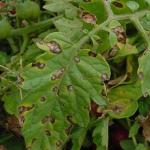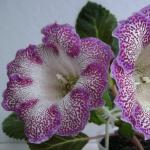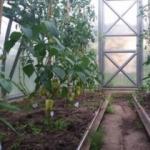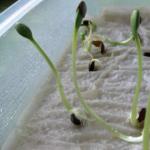Of the entire pumpkin family, butternut squash is the most delicious and sweet. It is distinguished by its juicy, fibrous pulp, which has a pleasant aroma and orange color. Thanks to these properties, butternut squash varieties are very popular among gardeners.
 In addition to excellent taste, many of the best varieties of nutmeg pumpkins have a long shelf life and a high content of vitamins and microelements. Butternut squash fruits vary in shape, but many have thin skins that are easy to cut off.
In addition to excellent taste, many of the best varieties of nutmeg pumpkins have a long shelf life and a high content of vitamins and microelements. Butternut squash fruits vary in shape, but many have thin skins that are easy to cut off.
Unlike the variety, butternut squash seeds and flesh can vary in color. If we compare others, nutmeg varieties are thermophilic, so they are grown in the southern regions.
Butternut Pearl Pumpkin
 Nutmeg Pearl is a mid-season variety that takes about 110 days to ripen. Pumpkin fruits have a round-cylindrical shape with a bright color, its pulp is juicy, thick and soft, and its peel is thin. In order for the Muscat Pearl pumpkin to produce a good harvest, it is necessary to create the most favorable conditions for it, the humidity should be 60-70%, and the air should warm up to 180-200 degrees. The Muscat Pearl pumpkin variety is a fairly powerful plant that produces 4-7 lateral shoots. Its leaves are distinguished by white spots, dark green color and pentagonal shape.
Nutmeg Pearl is a mid-season variety that takes about 110 days to ripen. Pumpkin fruits have a round-cylindrical shape with a bright color, its pulp is juicy, thick and soft, and its peel is thin. In order for the Muscat Pearl pumpkin to produce a good harvest, it is necessary to create the most favorable conditions for it, the humidity should be 60-70%, and the air should warm up to 180-200 degrees. The Muscat Pearl pumpkin variety is a fairly powerful plant that produces 4-7 lateral shoots. Its leaves are distinguished by white spots, dark green color and pentagonal shape.
Nutmeg pumpkin vitamin
 This variety is late, since the period from germination to the first harvest is 140 days. Ripe fruits have a characteristic brown color with small splashes of yellow and greenish shades. The shape of the nutmeg pumpkin has ribs with an oval or cylindrical shape. The flesh of this variety is crisp, juicy, sweet and bright orange in color. The average weight of one pumpkin is no more than 5 kg; it is stored well and does not require special conditions.
This variety is late, since the period from germination to the first harvest is 140 days. Ripe fruits have a characteristic brown color with small splashes of yellow and greenish shades. The shape of the nutmeg pumpkin has ribs with an oval or cylindrical shape. The flesh of this variety is crisp, juicy, sweet and bright orange in color. The average weight of one pumpkin is no more than 5 kg; it is stored well and does not require special conditions.
Pumpkin Muscat de Provence
 This variety is medium-late, as it takes 110-115 days for the fruit to fully ripen. Regarding the shape, the Provençal nutmeg pumpkin produces round and slightly flattened fruits with characteristic grooves; the average weight of the pumpkin is no more than 4 kg. If the seeds are planted at a great distance from each other and the soil is fertilized, the fruits can reach 8 kg. The pumpkin pulp is dense, bright orange in color, and contains a lot of sugar and carotene.
This variety is medium-late, as it takes 110-115 days for the fruit to fully ripen. Regarding the shape, the Provençal nutmeg pumpkin produces round and slightly flattened fruits with characteristic grooves; the average weight of the pumpkin is no more than 4 kg. If the seeds are planted at a great distance from each other and the soil is fertilized, the fruits can reach 8 kg. The pumpkin pulp is dense, bright orange in color, and contains a lot of sugar and carotene.
The fruits can be stored for a long time, since the Muscat pumpkin of Provence is resistant to disease. On average, its shelf life is 4 months. The fruits of this variety have an attractive presentation and excellent taste. In cooking, Muscat de Provence pumpkin is used to make juices and purees. The variety is heat-loving, therefore not suitable for planting in cold areas; the stems of the plant are thick, but fragile, creeping.
Pumpkin Guitar
 This is a mid-season variety that takes 110-120 days to grow. The fruits have an elongated shape and bright orange pulp, which has excellent taste. With good care, Guitar pumpkin produces fruits weighing up to 8 kg, which are stored for a long time. On average, the length of the Guitar pumpkin is about 70-80 cm, but on fertile soils this figure reaches one meter.
This is a mid-season variety that takes 110-120 days to grow. The fruits have an elongated shape and bright orange pulp, which has excellent taste. With good care, Guitar pumpkin produces fruits weighing up to 8 kg, which are stored for a long time. On average, the length of the Guitar pumpkin is about 70-80 cm, but on fertile soils this figure reaches one meter.
The surface of the fruit is smooth and the peel is thin; the pumpkin pulp occupies 90-95%, which distinguishes this variety from others. When the fruits are ripe, they acquire a bright orange color.
Pumpkin Trombone
 The fruits of this variety have a bizarre, twisted shape and are very long. Their flesh is bright orange in color and has excellent taste. The fruit can be stored for more than a year and does not lose its nutrients. Trombone pumpkin takes about 110 days to fully ripen. The pumpkin skin is thick and the flesh is very aromatic. On average, the weight of the fruit is up to 8 kg, but with good soil - up to 18 kg.
The fruits of this variety have a bizarre, twisted shape and are very long. Their flesh is bright orange in color and has excellent taste. The fruit can be stored for more than a year and does not lose its nutrients. Trombone pumpkin takes about 110 days to fully ripen. The pumpkin skin is thick and the flesh is very aromatic. On average, the weight of the fruit is up to 8 kg, but with good soil - up to 18 kg.
In cooking, a lot of dishes are prepared from this pumpkin - these are cakes, puddings, candied fruits, and pastries. Trombone pumpkin is also used to decorate suburban areas, as its shape is unique. To obtain maximum fruit weight, it is necessary to provide the plant with fertile soil and leave no more than one ovary on each vine; the rest are removed. The length of the fruit of this pumpkin reaches 50 cm.
Pumpkin Miracle-Yudo

This is a unique vegetable that can be consumed raw. It contains a huge amount of carotene and sugars. The fruits are oval in shape and reach 6-8 kg. The pumpkin peel is orange in color with a characteristic mesh pattern and a gray coating. The flesh of the vegetable is bright orange with red veins. In winter, Chudo-Yudo pumpkin is perfectly stored and used for preparing various salads, juice, and casseroles.
The average weight of a pumpkin is 5-8 kg, but with well-fertilized soil it reaches 20 kg or more. The color of the peel, which distinguishes this variety of pumpkin, appears only after the fruits have fully ripened, that is, at the end of the growing season. In addition to cooking, Miracle Yudo pumpkin is widely used in medicine; its pulp is an excellent diuretic, increases the elasticity of blood vessels and cleanses them, removes toxins from the body. In addition, pumpkin has a beneficial effect on the body in case of hypertension, heart disease, cholecystitis, and helps fight obesity.
Pumpkin Barbara
Of all the nutmeg varieties, Barbara pumpkin is considered the highest yielding and can also be grown in many regions of our country.
 It is adapted to any conditions and is a universal hybrid. Over a long period, the plant sets fruit and is perfectly resistant to disease. Pumpkin has an attractive color, has a hard peel and early ripening, so the time from sowing to the initial stage of peel formation is only 45 days.
It is adapted to any conditions and is a universal hybrid. Over a long period, the plant sets fruit and is perfectly resistant to disease. Pumpkin has an attractive color, has a hard peel and early ripening, so the time from sowing to the initial stage of peel formation is only 45 days.
Ripe fruits begin to be harvested after 85 days. The fruits differ from other varieties by longitudinal dark green stripes. The average fruit weight is about 2-6 kg, but with fertile soil, pumpkins reach 15 kg. The pumpkin pulp is of medium thickness, light in color and has excellent taste.
New butternut squash
The nutmeg pumpkin group includes a lot of varieties that can be large-fruited and medium-sized, with hard and soft skin, with a long and medium shelf life.
 But in any case, the fruits have an excellent taste, high nutritional value, and are stored well. Butternut squash fruits can be elongated or concentrated in one direction. Pumpkin seeds come in a variety of shades, ranging from dark yellow to brown.
But in any case, the fruits have an excellent taste, high nutritional value, and are stored well. Butternut squash fruits can be elongated or concentrated in one direction. Pumpkin seeds come in a variety of shades, ranging from dark yellow to brown.
Most varieties of butternut squash are heat-loving, but there are also universal varieties that are adapted to colder climates. To harvest on time, some of the mid-season ones are planted with seedlings and harvested before the first frost. These pumpkins finally ripen in warehouses, cellars or basements. Of the latest new products that the nutmeg pumpkin received, a description of the variety is presented below.
Pumpkin Peanut Butter
 This is an early ripening variety of nutmeg pumpkin, which was bred in Germany. Its seeds are planted as seedlings and a month later transplanted into open ground, when the soil warms up to 15 degrees. Pumpkin fruits are pear-shaped and weigh up to 4 kg. The peel of the fruit is cream-colored, and the flesh is bright orange, dense, very juicy, and has a nutmeg aroma. In cooking, pumpkin Peanut oil is used to prepare many dishes, juices, and casseroles.
This is an early ripening variety of nutmeg pumpkin, which was bred in Germany. Its seeds are planted as seedlings and a month later transplanted into open ground, when the soil warms up to 15 degrees. Pumpkin fruits are pear-shaped and weigh up to 4 kg. The peel of the fruit is cream-colored, and the flesh is bright orange, dense, very juicy, and has a nutmeg aroma. In cooking, pumpkin Peanut oil is used to prepare many dishes, juices, and casseroles.
Pumpkin can be stored for quite a long time without losing its taste. Its pulp contains a large amount of carotene, which is 2-3 times higher than carrots. Pumpkin variety Peanut butter is often used to prepare dishes from the diet menu, because the product improves metabolism, removes toxins from the body, restores metabolism, and helps strengthen the immune system. Pumpkin is readily used in restaurants for preparing salads and desserts.
Pumpkin Nut Butter

This variety is classified as mid-season, as the fruit ripening period is 125-130 days. To obtain an early harvest, pumpkin seeds are sown under fluorescent lamps and a temperature of 25-30 degrees is created. It is worth noting that Pumpkin Nut Butter is unique. As the fruit grows, a piece can be cut off and used for its intended purpose; the rest of the pumpkin does not rot, but is covered with a new peel, continuing its growth.
As the plant grows, it produces long vines and sets many fruits. In cooking, pumpkin is used to prepare salads, cereals, soups, casseroles, eaten stewed, fried, baked, candied fruits and juice are prepared from it. Pumpkin fruits and nut oil can be stored for a long time and do not lose their taste.
In one article it is impossible to consider all varieties of nutmeg pumpkins. For example, there are also these: Butternut squash (walnut), Kuban pumpkin, Grand Slam.
It is customary to start a conversation about pumpkin recipes with pumpkin porridge. It is not in this selection of 9 top recipes, although I will definitely link to the classic recipe from another page. And I will definitely remind you of the well-known: pumpkin is a universal vegetable. In the strictest sense of the word.
You can make anything from pumpkin, from bread to candy. Pumpkin is stewed, baked, boiled, fried, and eaten raw in salads. They even eat flowers (stuffed). Not to mention the seeds.
Pumpkin makes fabulous cakes, pies and cookies. Candied pumpkin and dried wedges are delicious. And pumpkin pickled in jars for the winter is just as good as in jam.
It is clear that the pumpkin has a magical background, because it is not only “food”, but also the heroine of one of the most wonderful holidays. It contains carotenoids and a whole pharmacy. In a word, this bright beauty has an interesting “personality”. Therefore, let’s arm ourselves with forks and spoons, as well as an orange mood, and sketch out a small list of top recipes that can be prepared from pumpkin for your bon appetit.
Pumpkin pie


About pumpkin recipes with love, Magic Food.
Butternut squash is a real miracle for the gardener. A fragrant, sweet and juicy vegetable that tastes very much like melon. The product is used to prepare soups, casseroles, and stuffed dishes.
In the article we will look at the muscat variety Trombone, which is grown by both novice gardeners and experienced gardeners. The vegetable has an unusual curved shape, which is why it got its name. Let's find out what this pumpkin is famous for and how to get a rich and tasty harvest on your plot.
An unpretentious and cold-resistant variety is cultivated in the south, in the middle zone, in the Urals and Siberia. Butternut squash is grown mainly in seedlings to get the largest yield.
Distinctive features
The plants are compact, two bushes fit on 1 sq.m.. The leaf blade is wide, heart-shaped, rich green in color. The lashes are medium length, thin. The root system is powerful and develops quickly.
Fruit characteristics and yield
Original pumpkins are shaped like a trombone. The length of the vegetable is about 50 cm, weight varies from 6 to 8 kg. The bark is dense and elastic, in the stage of technical ripeness the color is green, in biological ripeness it is dark orange.

The pulp is dense and aromatic, it is actively used in cooking. The yield is good; from 1 square meter, summer residents harvest about 10 kg of unusual vegetables.
Interesting! In China, pumpkin is given magical meaning. Since ancient times, it has been believed that the vegetable is capable of absorbing evil forces and protecting its owner from them. Therefore, they often hung a pumpkin in front of their house; it served as a kind of talisman against troubles.
How to grow
Pumpkin is an unpretentious plant, but when planting it is necessary to take into account basic agrotechnical rules. Let's consider the rules for planting and caring for crops.
Planting seeds in open ground
The first step is to disinfect the seeds. The procedure is necessary in order to destroy pathogens of dangerous diseases on the surface of the seeds.
Disinfection is carried out using the drug “Formalin 40%”. For 300 ml of water at room temperature, 3 g of the drug is required. The ingredients are mixed together, the seeds are placed in a fabric bag and immersed in water. After 5 minutes, remove the bag and leave for 2 hours at room temperature.
Afterwards, the seeds are removed and dried well.. Disinfection of seeds improves their germination and increases immunity to diseases and pests.
Important! After disinfection, the seeds are germinated. To do this, they are soaked in warm water for 2-3 hours, then wrapped in a damp cloth and put in a warm place. The swollen seeds are selected for sowing and undergo a hardening procedure: placed in the freezer for 3 days. After which they begin transplanting into open ground.
Planting pumpkins in hilly, sunny beds. The best predecessors for pumpkin crops are potatoes, cabbage, greens or legumes. It is not recommended to plant pumpkin next to tall, upright plants so that they do not block sunlight.
The best soil for the crop is a mixture of sandy and loamy soil. This composition retains moisture well and warms up quickly. The Trombone variety is planted according to a 70x100 or 80x80 cm pattern. It is recommended to place 2-4 seeds in one hole to achieve better germination.
Planting seedlings
A clean container is required to prepare seedlings. Many gardeners prefer to plant pumpkins in special peat tablets or pots. They are affordable, easy to use and made from environmentally friendly materials.
However, it is not prohibited to plant seedlings in ordinary flower pots., wooden boxes or plastic cups. The main thing is to thoroughly rinse the container and dry it before planting. Gardeners use garden soil or purchased mixtures as seedling soil.
 note:
note:
- Garden soil is additionally fertilized with peat or humus, and river sand or dry sawdust is added for looseness. Before planting, the soil is heated in the oven; the hot air destroys pathogenic microflora and protects against the appearance of weeds.
- Ready-made formulations already contain all the elements necessary for healthy development. Manufacturers claim that such land is disinfected and safe, but many summer residents prefer to disinfect the soil themselves.
Pumpkin seedlings require sunlight and heat. If daylight hours are short, then additional lighting is provided using fluorescent lamps. Water the seedlings moderately, once every 5-6 days. Before watering, it is recommended to carefully loosen the soil so that the soil becomes lighter and airier. Transplant the seedlings into open ground after the last spring frosts have passed. When transplanting, you need to be careful not to damage the still weak seedlings or break the fragile leaves.
Care
During the first week, the seedlings are covered with a thin film to protect the bushes from wind and rain. Water the plant with warm water at the root. Water should not get on fruits and leaves, otherwise the risk of diseases and pests increases. If possible, periodically use an infusion of onion peels or nettle leaves instead of water. These folk remedies protect bushes from adverse factors. Stop watering 2 weeks before harvest.
Fertilize the beds after watering. Pumpkin culture loves organic fertilizers: manure, liquid droppings, ash or compost. They improve the taste of fruits and accelerate ripening. Organics are alternated with mineral complexes that saturate the pumpkin with nitrogen, calcium, magnesium, and phosphorus. Excellent balanced fertilizers: “Kimira”, “Zdraven”, “Magic Leika”. Before use, be sure to read the instructions and recommended dosage.
Important! Dry fertilizers are absorbed much more slowly than liquid ones. When contacting the soil, dry food causes burns, so it is recommended to moisten the soil before fertilizing. In total, 2-3 procedures are carried out per season, mineral nutrition is alternated with organic nutrition.

Features of cultivation and possible difficulties
In addition to watering and fertilizing, the pumpkin needs regular loosening. It is carried out once every 5-7 days. Loosening allows you to get rid of unwanted weeds, retain moisture in the soil and strengthen the root system. The depth of loosening is about 5-8 cm. As a rule, the operation is carried out before watering so that the soil is saturated with oxygen. At the same time, it is necessary to maintain healthy microflora in the beds: remove garbage, weeds, and foreign vegetation.
Bush shaping deserves special attention. The vines of the Trombone variety are long and often tangled. It is necessary to untangle them and lay them on the bed, sprinkling them with earth in several places. As soon as 5-6 leaves are formed, the side shoots are removed, leaving only those on which 2-3 fruits have already formed. The top is pinched so that all the nutrition is spent on the development of pumpkins, and not on the growth of green mass.
At the first signs, wood ash is sprinkled on the beds and watered with plenty of water. In addition, gardeners We advise you to adhere to the following recommendations:
- follow the rules of crop rotation, do not plant pumpkins in the same bed for more than two years in a row;
- when using water from springs, preheat it in the sun for three hours;
- if possible, install a drip irrigation system on the site;
- remove side shoots and untangle lashes;
- carry out preventive measures to protect against pests and diseases.
Diseases and pests
Among insects, wireworms have the greatest negative impact. Worms live deep underground and eat the root system of the plant. Soon the roots die, causing the stem to wither and the fruits to rot. For prevention purposes, it is recommended to scatter dry eggshells over the garden bed.
During the fruiting period, spider mites, slugs and aphids become active. Pests appear due to improper care and sudden climate changes. Spraying with Bordeaux mixture or Oxychom helps prevent the appearance of insects. Many insects are difficult to notice with the naked eye, so gardeners are advised to regularly inspect bushes and fruits for the presence of uninvited “guests”.

The Trombone variety is rare, but sometimes suffers from powdery mildew.. The disease manifests itself in the form of a white coating, and foliar feeding with whey and iodine helps prevent its occurrence. Another disease, root rot, occurs due to an excess of fertilizers and weeds. They get rid of rot using the drug “Hom”. The product is applied after watering, 2-3 times per season.
Harvesting and application
 Harvest 3-3.5 months after planting. The fruits ripen gradually. First, the densest vegetables that have acquired a rich orange hue are removed. A ripe pumpkin should have a pleasant sweetish aroma. For long-term storage, vegetables are placed in a dark place where the humidity level is no more than 85% and the temperature is no less than +10°C. Pumpkins with damage and scratches are recommended to be eaten immediately.
Harvest 3-3.5 months after planting. The fruits ripen gradually. First, the densest vegetables that have acquired a rich orange hue are removed. A ripe pumpkin should have a pleasant sweetish aroma. For long-term storage, vegetables are placed in a dark place where the humidity level is no more than 85% and the temperature is no less than +10°C. Pumpkins with damage and scratches are recommended to be eaten immediately.
Delicious and healthy pumpkin juice is prepared from the vegetable.. This drink has not only a vitamin composition, but also a calming effect. The fruits are also used for baking; their sweet taste goes harmoniously with meat dishes, vegetable side dishes and salads. Diet lovers use the vegetable to make muffins, cheesecakes, pies and cakes.
Interesting! The recipe for American pumpkin pie is extremely popular among chefs. It is prepared for special occasions - Christmas or Halloween. Before the advent of electricity, the delicacy was cooked on a stove; today, pumpkin pie is made in a slow cooker or on a special grill. Baking is especially delicious if you add honey or cinnamon to it.
Advantages and disadvantages of the variety
The advantages of the variety include the original appearance of the fruits, pumpkins are often used as a basis for decorative crafts. The taste of the vegetable is excellent, as expected; nutmeg pumpkin has a bright honey aroma and juicy pulp. Trombone rarely gets sick and shows stable and high productivity.
The variety has no significant disadvantages, however, some gardeners believe that other nutmeg varieties have a more pronounced sugar taste.

